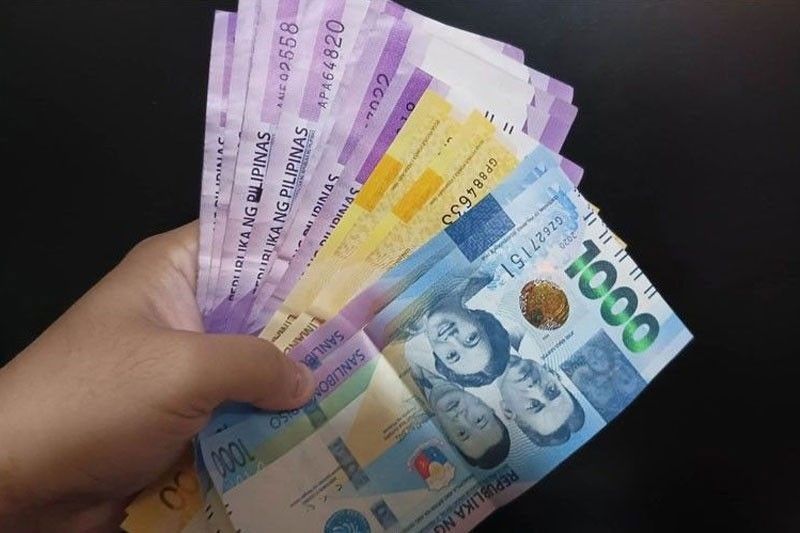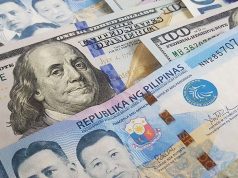Peso extends losing streak to hit near three-month low vs dollar

THE PESO plummeted to a near three-month low on Thursday, returning to the P57 level, after the Bangko Sentral ng Pilipinas (BSP) delivered a second straight interest rate cut.
The local unit closed at P57.45 per dollar, sinking by 47 centavos from its P56.98 finish on Wednesday, Bankers Association of the Philippines data showed, extending its losing streak to an eighth consecutive session.
This was the peso’s worst finish in almost three months or since its P57.69-a-dollar close on March 26.
The peso traded weaker than Wednesday’s close the entire day as it opened Thursday’s session at P57.10 against the dollar, which was already its intraday best. Its worst showing was its closing level of P57.45 versus the greenback.
Dollars exchanged rose to $1.83 billion on Thursday from $1.27 billion on Wednesday.
The peso weakened as the divergence in the policy tones of the BSP and the US Federal Reserve raised concerns over prospects of a narrowing interest rate differential, a trader said in a phone interview.
Rizal Commercial Banking Corp. Chief Economist Michael L. Ricafort said in a Viber message that the BSP’s latest rate cut narrowed its interest rate differential with the US central bank to 75 basis points (bps), “the narrowest ever and seen since the latter part of 2023.”
On Thursday, the BSP’s policy-setting Monetary Board reduced the target reverse repurchase rate by 25 bps to 5.25%, as expected by 15 out of 16 analysts in a BusinessWorld poll last week.
The central bank has now slashed rates by a total of 50 bps this year following a similar cut in April. This brought total reductions since August 2024 to 125 bps.
BSP Governor Eli M. Remolona, Jr. said they could deliver one more 25-bp cut this year, depending on the data.
The central bank chief also said on Thursday that the rate differential is just one of many factors that affects the peso-dollar exchange rate.
“We used to worry about 100 bps between our policy rate and the Fed policy rate. We worry a little bit about that still, but it’s now more about relative [hawkishness and] dovishness,” Mr. Remolona said.
He said the peso’s recent weakness was is mainly a product of global risk aversion due to developments overseas, adding that they “won’t have enough reserves” to heavily intervene in the market just to stem the currency’s fall.
Meanwhile, the Fed on Wednesday kept its benchmark overnight rate steady at the 4.25%-4.5% range, with policymakers signaling two cuts this year. However, Federal Chair Jerome H. Powell cautioned against putting too much weight on that view, and said he expects “meaningful” inflation ahead as consumers pay more for goods due to the Trump administration’s planned import tariffs, Reuters reported.
“No one holds these… rate paths with a great deal of conviction, and everyone would agree that they’re all going to be data-dependent,” Mr. Powell said in a press conference after the end of a two-day US central bank meeting where policymakers slowed their overall outlook for rate cuts in response to a more challenging outlook of weaker economic growth, rising joblessness, and faster price increases.
If not for tariffs, Mr. Powell said, rate cuts might actually be in order, given that recent inflation readings have been favorably low.
But a cost shock is coming, he insisted, with producers, manufacturers and retailers still involved in a complicated struggle over who will pay the levies imposed so far, and President Donald J. Trump still contemplating an aggressive set of import duties that could go into effect early next month.
The trader and Mr. Ricafort added that the dollar’s recent strength and the increase in oil prices due to the ongoing conflict between Israel and Iran also continued to put pressure on the peso.
The dollar firmed on Thursday, buoyed by safe-haven demand due to the looming threat of a broader conflict in the Middle East and possible US involvement, Reuters reported.
After a muted start in Asia hours, the dollar advanced across the board, weighing heavily on risk sensitive currencies after a report said US officials are preparing for the possibility of a strike on Iran in the coming days.
Rapidly rising geopolitical tensions have led to the dollar swiftly reclaiming its safe-haven status, making inroads against the yen, euro and the Swiss franc.
Iran and Israel traded further air attacks on Thursday, with the conflict entering its seventh day. Concerns over potential US involvement have also grown, as Mr. Trump kept the world guessing about whether the United States will join Israel’s bombardment of Iranian nuclear sites.
The conflict has heightened fears of broader regional instability, compounded by the spillover effects of the Gaza war.
Some analysts said investors were looking to cover their short-dollar positions.
The dollar index, which measures the currency against six other units, rose 0.11% to 99 and was set for about a 0.9% gain for the week, its strongest weekly performance since late January.
For Wednesday, the trader expects the peso to move between P57.30 and P57.65 per dollar, while Mr. Ricafort expects it to range from P57.35 to P57.55. — AMCS with Reuters



